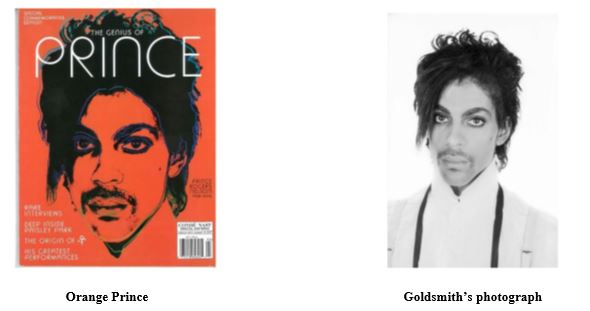It has been nearly thirty years since the US Supreme Court has considered whether a creative work qualifies as a transformative use under the Copyright Act. The last time was in 1994, when the Court in Campbell v. Acuff-Rose Music, Inc. stated that the central inquiry of transformative use is “whether the new work merely supersede[s] the objects of the original creation, or instead adds something new, with a further purpose or different character, altering the first with new expression, meaning, or message.” Since then, lower courts have assessed whether a use is transformative by focusing on the latter part of the Court’s articulated inquiry: whether “new expression, meaning, or message” has been added to the original copyrighted work.
On May 18, 2023, the Court issued its long-awaited decision in The Andy Warhol Foundation for the Visual Arts, Inc. v. Goldsmith. The decision is notable for at least two reasons. First, it is the first time the Court has considered whether a visual work qualifies as transformative use. Second, and perhaps more importantly, the decision shifts the focus of the transformative use assessment to the first part of the Campbell inquiry: “whether the new work merely supersede[s] the objects of the original creation.” In a 7-2 decision, the Court affirmed the Second Circuit’s ruling that AWF’s licensing of Warhol’s “Orange Prince” in 2016 for use on a commemorative edition magazine cover (below, left) does not constitute fair use of Goldsmith’s copyrighted photograph of Prince (below, right).
The question considered by the Court in Warhol was a narrow one: whether the first of four fair use factors—“the purpose and character of the use, including whether such use is of a commercial nature or is for nonprofit educational purposes”—favors finding AWF’s licensing of Warhol’s Orange Prince in 2016 for use on a magazine cover a fair use. AWF relied on the latter part of the Court’s inquiry in Campbell, contending that use is transformative when it can “reasonably be perceived” to “add something new, with a further purpose or different character, altering the first with new expression meaning, or message.” Goldsmith argued that a use is transformative only where copying is necessary to accomplish a distinct creative end, like commenting on or parodying the original. The United States, appearing as amicus curiae, submitted that, while “no single test or shorthand formulation can capture all the ways in which particular uses can be fair,” AWF’s use was not transformative because it “served the same purpose that Goldsmith’s own photographs have previously served”—namely, “a visual depiction of Prince to accompany an article about Prince in a popular print magazine.”
The Court’s Decision
In an opinion written by Justice Sotomayor, and joined by Justices Thomas, Alito, Gorsuch, Kavanaugh, Barrett, and Jackson, the majority held that the purpose and character of AWF’s licensing of Orange Prince in 2016 were not transformative and therefore do not favor a fair use defense to copyright infringement. According to the majority, “[i]f an original work and a secondary use share the same or highly similar purposes, and the secondary use is of a commercial nature, the first factor is likely to weigh against fair use, absent some other justification for copying.” Applying that test to the specific use of Orange Prince at issue, the majority determined that even though Orange Prince adds new expression to Goldsmith’s photograph, AWF’s licensing of Orange Prince in 2016 served substantially the same purpose as that of Goldsmith’s copyrighted work: “to illustrate stories about Prince.”
The majority emphasized that its analysis of whether AWF’s use was transformative was limited to AWF’s licensing of Orange Prince in 2016; it expressed no opinion on the purpose and character of the creation of the original Prince Series works, or its display in a 1984 issue of Vanity Fair, which were done pursuant to a license from Goldsmith. The majority also noted that AWF’s licensing of Orange Prince in 2016 was commercial in nature. Though not dispositive, such commerciality “tends to weigh against a finding of fair use.”
Elaborating on the point that the transformative nature of a use may outweigh its commercial nature and favor finding fair use, the majority discussed Warhol’s “Campbell’s Soup Cans” series at length. The series of works, like the one shown below, depicts the copyrighted Campbell’s Soup logo. That logo, according to the majority, serves the purpose of advertising or promoting Campbell’s Soup. That purpose is therefore distinguishable from the apparent purpose of the logo as depicted in the Campbell’s Soup Cans series—to comment on consumerism.
The majority then addressed AWF’s position that Orange Prince’s use of the copyrighted work is transformative in the fair use sense because it adds new meaning or message—namely, a comment on “the dehumanizing nature of celebrity.” The majority rejected AWF’s position. Acknowledging that the Court in Campbell described transformative use as one that “alter[s] the first [work] with new expression, meaning, or message,” the majority rejected the notion that Campbell may be understood as holding that any use that adds some new expression, meaning, or message is necessarily transformative. According to the majority, if understood in that way, Campbell would effectively moot the copyright owner’s exclusive right to prepare derivative works, which typically “recast, transform, or adapt,” the original; add new expression, meaning or message; or provide new information, new aesthetics, new insights and understandings.
Justice Gorsuch, in a concurring opinion joined by Justice Jackson, rejected AWF’s position primarily because it would force “judges to speculate about the purpose an artist may have in mind when working on a particular project,” or “try their hand at art criticism and assess the aesthetic character of the resulting work.” The concurring opinion also attempted to cabin the effects of the majority opinion on other uses of Orange Prince, noting that displaying it in a nonprofit museum or even a for-profit book for the purpose of “commenting on 20th-century art…might well point to fair use.”
Two Justices dissented. In a dissenting opinion, Justice Kagan, joined by Chief Justice Roberts, argued that when assessing the first factor of fair use, the focus should be on whether the work in question “adds something new, with a further purpose or different character, altering the [original] with new expression, meaning, or message.” The dissent concluded with a grave repudiation of the majority for recasting the first-factor inquiry in a way that “will stifle creativity” and “make our world poorer.”
To which the majority optimistically responded: “[i]t will not impoverish our world to require AWF to pay Goldsmith a fraction of the proceeds from its reuse of her copyrighted work.” These payments, according to the majority, “are incentives for artists to create original works in the first place.”
Practical takeaways
It remains to be seen how well the claims of the majority and dissent will age. However, the art community now has the task of sorting out the practical effects of the Court’s clarified test for transformative use. The test shifts the focus of that test away from whether “new expression, meaning, or message” has been added to a new work that incorporates a copyrighted work, and instead on the respective purposes served by the copyrighted work and the new work, which could make it more challenging for artists to freely create new works that are inspired by, or borrow from, a copyrighted work. Artists will need to contemplate the respective purposes served by the inspired new work and the copyrighted work, and whether those purposes are substantially the same. Or, to avoid that issue altogether, artists may want to obtain the appropriate licenses before creating new works that incorporate copyrighted works.
As for art galleries and museums concerned by the Court’s opinion, their ability to display Warhol works or other artistic works that borrow from or incorporate prior copyrighted works will likely not be impacted adversely by the decision. Presumably, those galleries and museums display artistic works for purposes like depicting an artist’s particular painting style or showing how the particular work fits in a particular movement in art history. Such uses would likely be deemed transformative under the Court’s articulated test.

Receive insights from the most respected practitioners of IP law, straight to your inbox.
Subscribe for Updates

